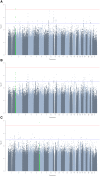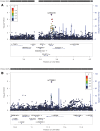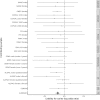Consortium-based genome-wide meta-analysis for childhood dental caries traits
- PMID: 29931343
- PMCID: PMC6097157
- DOI: 10.1093/hmg/ddy237
Consortium-based genome-wide meta-analysis for childhood dental caries traits
Abstract
Prior studies suggest dental caries traits in children and adolescents are partially heritable, but there has been no large-scale consortium genome-wide association study (GWAS) to date. We therefore performed GWAS for caries in participants aged 2.5-18.0 years from nine contributing centres. Phenotype definitions were created for the presence or absence of treated or untreated caries, stratified by primary and permanent dentition. All studies tested for association between caries and genotype dosage and the results were combined using fixed-effects meta-analysis. Analysis included up to 19 003 individuals (7530 affected) for primary teeth and 13 353 individuals (5875 affected) for permanent teeth. Evidence for association with caries status was observed at rs1594318-C for primary teeth [intronic within ALLC, odds ratio (OR) 0.85, effect allele frequency (EAF) 0.60, P 4.13e-8] and rs7738851-A (intronic within NEDD9, OR 1.28, EAF 0.85, P 1.63e-8) for permanent teeth. Consortium-wide estimated heritability of caries was low [h2 of 1% (95% CI: 0%: 7%) and 6% (95% CI 0%: 13%) for primary and permanent dentitions, respectively] compared with corresponding within-study estimates [h2 of 28% (95% CI: 9%: 48%) and 17% (95% CI: 2%: 31%)] or previously published estimates. This study was designed to identify common genetic variants with modest effects which are consistent across different populations. We found few single variants associated with caries status under these assumptions. Phenotypic heterogeneity between cohorts and limited statistical power will have contributed; these findings could also reflect complexity not captured by our study design, such as genetic effects which are conditional on environmental exposure.
Figures




References
-
- Kassebaum N.J., Bernabe E., Dahiya M., Bhandari B., Murray C.J.L., Marcenes W. (2015) Global burden of untreated caries: a systematic review and metaregression. J. Dent. Res., 94, 650–658. - PubMed
-
- Schuller A.A., van Dommelen P., Poorterman J.H.G. (2014) Trends in oral health in young people in the Netherlands over the past 20 years: a study in a changing context. Commun. Dent. Oral Epidemiol., 42, 178–184. - PubMed
-
- Philip N., Suneja B., Walsh L.J. (2018) Ecological approaches to dental caries prevention: paradigm shift or shibboleth? Caries Res., 52, 153–165. - PubMed
Publication types
MeSH terms
Substances
Grants and funding
- R01 DE012101/DE/NIDCR NIH HHS/United States
- R01 DE014899/DE/NIDCR NIH HHS/United States
- 201237/Z/16/Z/WT_/Wellcome Trust/United Kingdom
- R01 DE009551/DE/NIDCR NIH HHS/United States
- 076467/Z/05/Z/WT_/Wellcome Trust/United Kingdom
- R03 DE024264/DE/NIDCR NIH HHS/United States
- HHSN268200782096C/HG/NHGRI NIH HHS/United States
- U01 DE018903/DE/NIDCR NIH HHS/United States
- WT_/Wellcome Trust/United Kingdom
- P60 DE013076/DE/NIDCR NIH HHS/United States
- 202802/Z/16/Z/WT_/Wellcome Trust/United Kingdom
- MC_UU_12013/3/MRC_/Medical Research Council/United Kingdom
- MOP-82893/CIHR/Canada
LinkOut - more resources
Full Text Sources
Other Literature Sources
Medical

